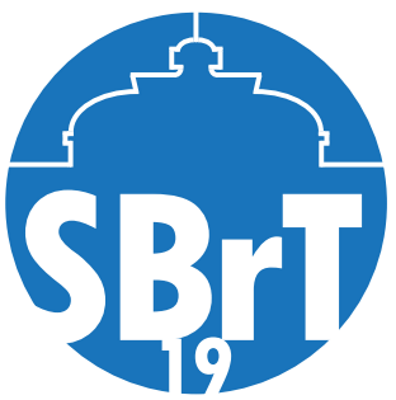
XXXVII Simpósio Brasileiro de Telecomunicações e Processamento de Sinais
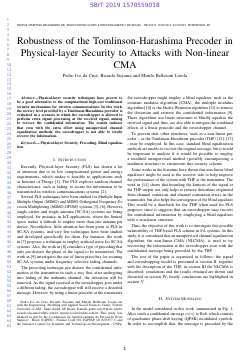
Robustness of the Tomlinson-Harashima Precoder in Physical-layer Security to Attacks with Non-linear CMA
Pedro Cruz, Ricardo Suyama, Murilo Bellezoni Loiola
DOI: 10.14209/sbrt.2019.1570559018
Keywords:
Abstract
Physical-layer security techniques have proven to be a good alternative to the computational high-cost traditional security mechanisms for wireless communications. In this work, the secrecy level provided by a Tomlinson-Harashima precoder is evaluated in a scenario in which the eavesdropper is allowed to perform extra signal processing at the received signal, aiming to recover the confidential information. The results indicate that even with the extra effort using unsupervised channel equalization methods, the eavesdropper is not able to totally recover the information.Download

Studies of indoor wave propagation and antenna diversity in UHF RFID systems
Luis C. Vieira, Nathan J Gomes, John Batchelor, Philippos Assimakopoulos, Lucas Schwendler Vieira
DOI: 10.14209/sbrt.2019.1570559022
Keywords:
Abstract
Analytical and experimental investigations considering indoor wave propagation and antenna diversity are presented for passive UHF RFID systems. Modelling results are reported for two-ray and three-ray reflection models, with the effect of floor and ceiling relative permittivity discussed. A novel multi-LOS multi-ray reflection model, considering transmit antenna diversity, is proposed with good results reported. From experiments, a receive diversity scheme shown the best performance in comparison with transmit diversity and no diversity cases. A promising performance improvement in the tag readability is also demonstrated (without antenna diversity) by simply placing an aluminium plate on the floor nearby a commercial tag.Download

Receptor para Sistemas de Comunicação por Luz Visível Baseados na Modulação OOK-M-FSK
Cassiano R Carneiro, Guilherme Marcio Soares, Henrique A. C. Braga, Pedro Almeida, Marlon Lucas Salmento, Ian Marson, Alexandre dos Santos
DOI: 10.14209/sbrt.2019.1570559026
Keywords:
Abstract
This work presents an analysis of the design and operation of a receiver for visible light communication systems based on the OOK-M-FSK modulation. The functional blocks of the circuit are presented, as well as the demodulation algorithm for the studied VLC signal. Experimental results shown the proper operation of the circuit and the algorithm, since the VLC OOK-M-FSK signal were correctly demodulated for several tests and studied conditions.Download

Plataforma para medição de diagrama de irradiação de antenas na faixa de microondas utilizando Arduino
Orlando M. Alvarenga, Vitor Luiz Mota, Vanessa Magri, Tadeu Ferreira, Leni Matos, Pedro Gonzalez Castellanos
DOI: 10.14209/sbrt.2019.1570559028
Keywords:
Abstract
Este artigo apresenta uma plataforma de medição do diagrama de irradiação de antenas de microondas utilizando dois motores de passos, com seus passos e direções de rotações remotamente controladas por um transmissor infravermelho, através de um módulo receptor integrado ao Arduino. Este protótipo amplia o conjunto de grandezas de medidas, possibilitando a realização de medições das antenas miniaturizadas tanto no plano horizontal quanto no plano vertical, e possivelmente o diagrama tridimensional com baixo custo de implementação.Download
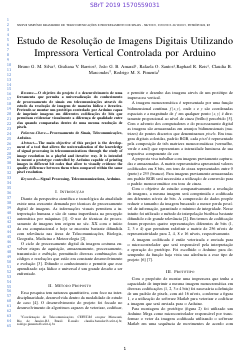
Estudo de Resolução de Imagens Digitais Utilizando Impressora Vertical Controlada por Arduino
Bruno G. M. Silva, Giuliana V. Barrios, João G. B. Amaral, Rafaela O. Santos, Raphael R. Reis, Claudia Barucke Marcondes, Rodrigo M.S. Pimenta
DOI: 10.14209/sbrt.2019.1570559031
Keywords:
Abstract
The main objective of this project is the development of a tool that allows the universalization of the knowledge of signal processing in telecommunications through the study of image resolution in a playful and iterative way. It is intended to mount a prototype controlled by Arduino capable of printing images in different bit codes that allow to visually evidence the quality difference between them when compared within the same pixel resolution.Download
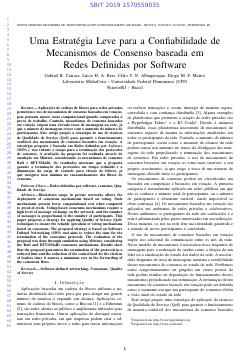
Uma Estratégia Leve para a Confiabilidade de Mecanismos de Consenso baseada em Redes Definidas por Software
Gabriel R. Carrara, Lucio Reis, Celio Albuquerque, Diogo Mattos
DOI: 10.14209/sbrt.2019.1570559035
Keywords:
Abstract
Aplicações de cadeias de blocos para redes privadas permitem o uso de mecanismos de consenso baseados em votação, pois possuem menor custo computacional quando comparados à prova de trabalho. Contudo, mecanismos de consenso baseados em votação exigem uma elevada troca de mensagens na rede, já que o número de mensagens cresce com o aumento do número de participantes. Este artigo propõe a estratégia de uso de técnicas de Qualidade de Serviço (QoS) para garantir o funcionamento confiável dos mecanismos de consenso baseados em votação. A estratégia proposta é baseada em Redes definidas por Software (SDN) e visa reduzir o tempo para a terminação dos protocolos de consenso. A avaliação da proposta foi realizada através de emulação em Mininet, considerando os mecanismos de consenso Raft e BFT-SMaRt. Os resultados mostram que a proposta garante a terminação dos protocolos em tempo reduzido e a diminuição da carga de controle para eleição de líderes, já que assegura taxa mínima no encaminhamento dos fluxos de consenso.Download
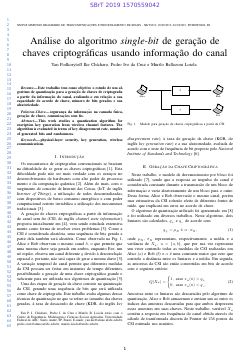
Análise do algoritmo single-bit de geração de chaves criptográficas usando informação do canal
Yan Podkorytoff Ike Chícharo, Pedro Cruz, Murilo Bellezoni Loiola
DOI: 10.14209/sbrt.2019.1570559042
Keywords:
Abstract
Este trabalho tem como objetivo o estudo de um algoritmo de quantização para a geração de chaves de criptografia a partir da informação do canal, avaliando-o em relação a sua capacidade de acordo de chave, número de bits gerados e sua aleatoriedade.Download
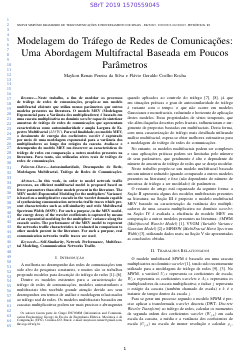
Modelagem do Tráfego de Redes de Comunicações: Uma Abordagem Multifractal Baseada em Poucos Parâmetros
Maykon Renan Pereira da Silva, Flávio Geraldo Coelho Rocha
DOI: 10.14209/sbrt.2019.1570559045
Keywords: Self-Similarity Network Performance Multifractal Modeling Communication Networks Traffic
Abstract
In this work, in order to model network traffic processes, an efficient multifractal model is proposed based on fewer parameters than other models present in the literature. The MEV model (Exponential Modeling for the multipliers' Variance) is based on a multiplicative cascade in the wavelet domain capable of synthesizing communication networks traffic traces which present characteristics such as self-similarity and wide Multifractal Spectrum Width (MSW). For such a purpose, in the MEV model, the energy decay of the wavelet coefficients is captured by means of an exponential modeling for the multipliers' variance along the cascade scales. The performance of the MEV model to represent the networks traffic characteristics is evaluated in comparison to other models present in the literature. For such a purpose, real communication networks traffic traces are used.Download
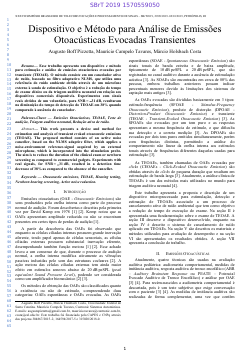
Dispositivo e Método para Análise de Emissões Otoacústicas Evocadas Transientes
Augusto B. Pizzetta, Maurício Tavares, Marcio H Costa
DOI: 10.14209/sbrt.2019.1570559050
Keywords:
Abstract
This work presents a device and method for estimation and analysis of transient evoked otoacoustic emissions (TEOAE). The proposed method consists on an active noise canceller, based on the NLMS adaptive filter, which applies a noise-environment reference-signal acquired by an external microphone which is incorporated into the stimulation probe. The aim is to reduce the duration of the clinical exam or newborn screening as compared to commercial gadgets. Experiments with real signals, for SNR = −31 dB, resulted in a detection time decrease of 38% as compared to the absence of the canceller.Download
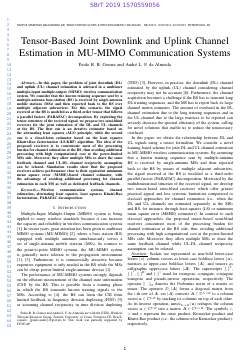
Tensor-Based Joint Downlink and Uplink Channel Estimation in MU-MIMO Communication Systems
Paulo R. B. Gomes, André de Almeida
DOI: 10.14209/sbrt.2019.1570559056
Keywords:
Abstract
In this paper, the problem of joint downlink (DL) and uplink (UL) channel estimation is adressed in a multiuser multiple-input multiple-output (MIMO) wireless communication system. We consider that the known training sequence sent by a multiple-antenna base-station (BS) is received by single-antenna mobile stations (MSs) and then reported back to the BS over multiple adjacent subcarriers. For this scenario, the signal received at the BS is modeled as a third-order tensor that follows a parallel factors (PARAFAC) decomposition. By exploiting the tensor structure of the received signal, we propose two semi-blind receivers for the joint estimation of the DL and UL channels at the BS. The first one is an iterative estimator based on the alternating least squares (ALS) principle, while the second one is a closed-form estimator based on the least squares Khatri-Rao factorization (LS-KRF) algorithm. The idea of the proposed receivers is to concentrate most of the processing burden for channel estimation at the BS, thus avoiding additional processing with high computational cost at the power-limited MSs side. Moreover, they allow multiple MSs to share the same feedback channel and UL-DL channel reciprocity assumption can be relaxed. Simulation results show that the proposed receivers achieve performance close to their equivalent minimum mean square error (MMSE)-based channel estimator, with the advantage of avoiding additional processing for channel estimation in each MS as well as dedicated feedback channels.Download